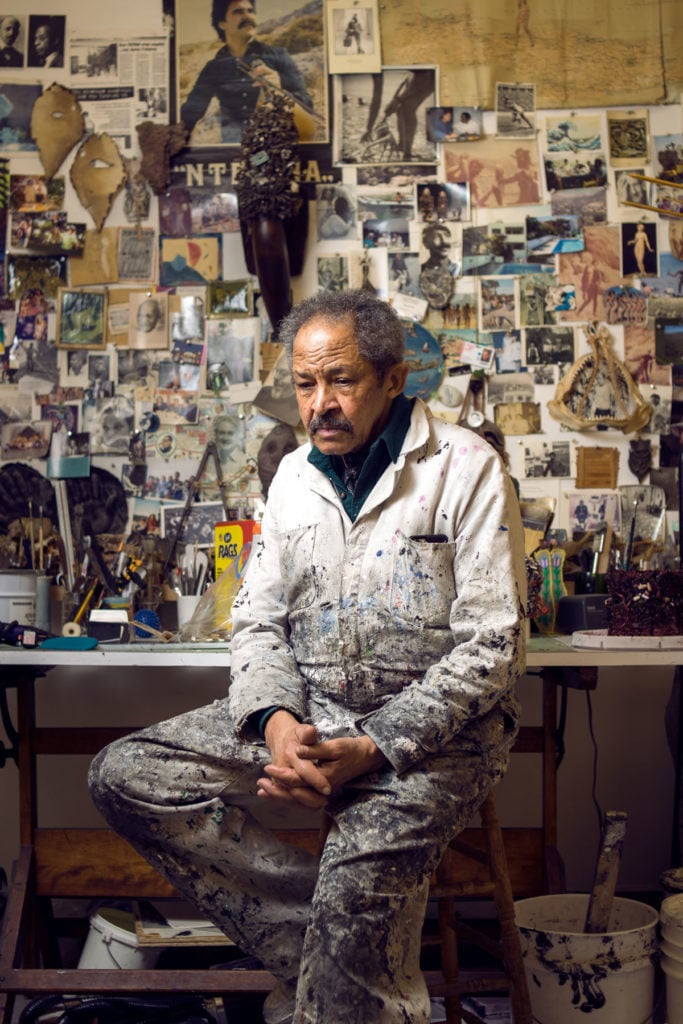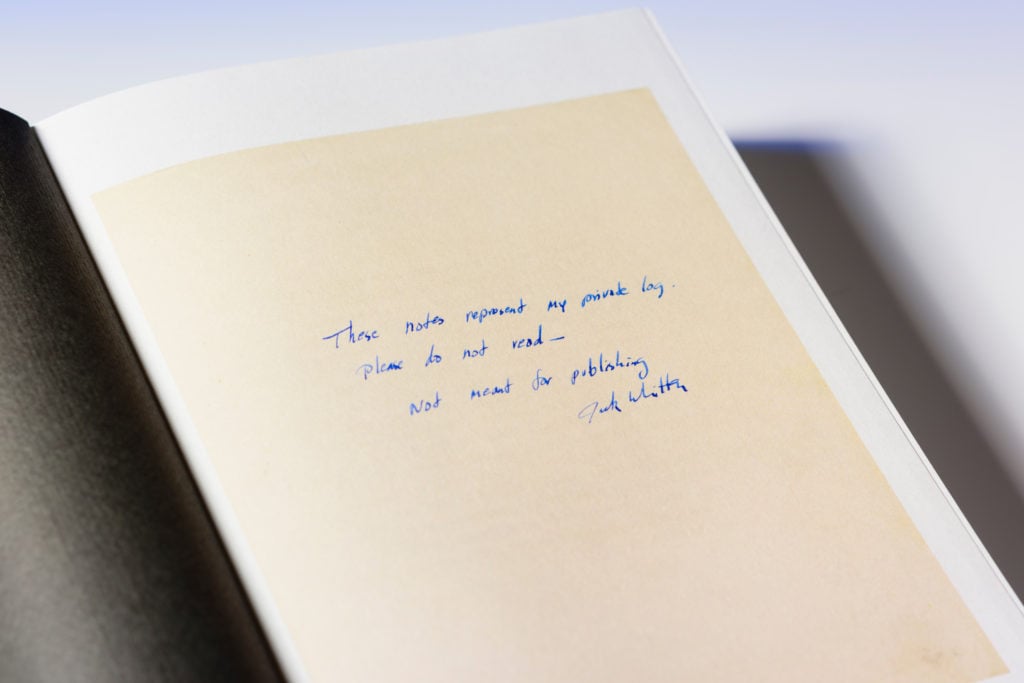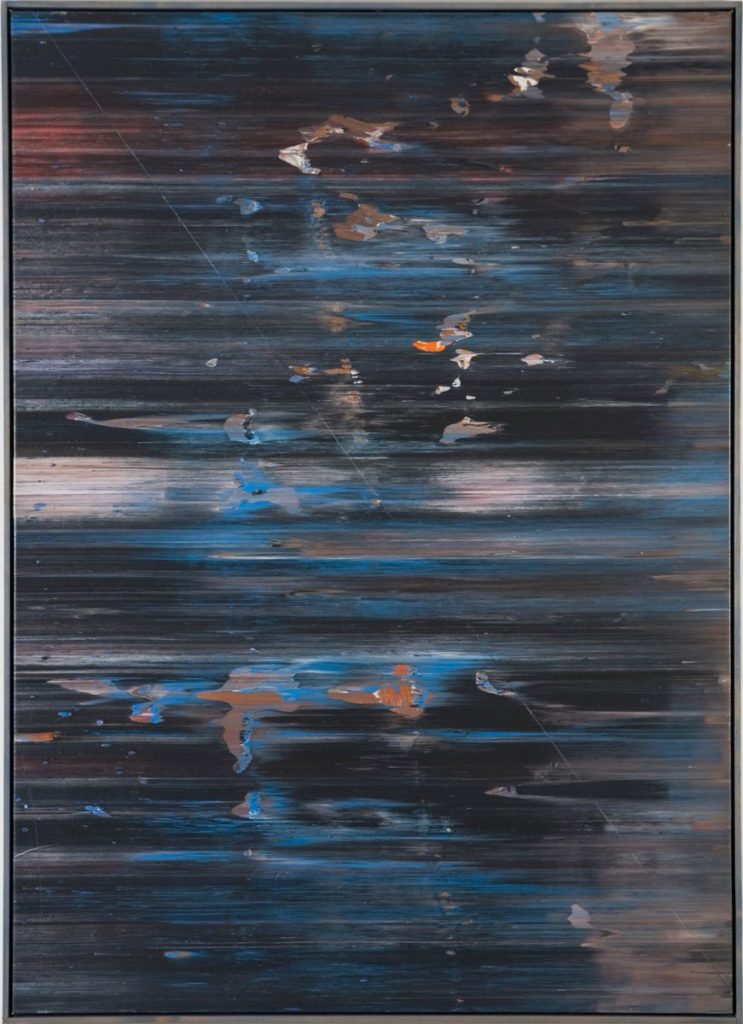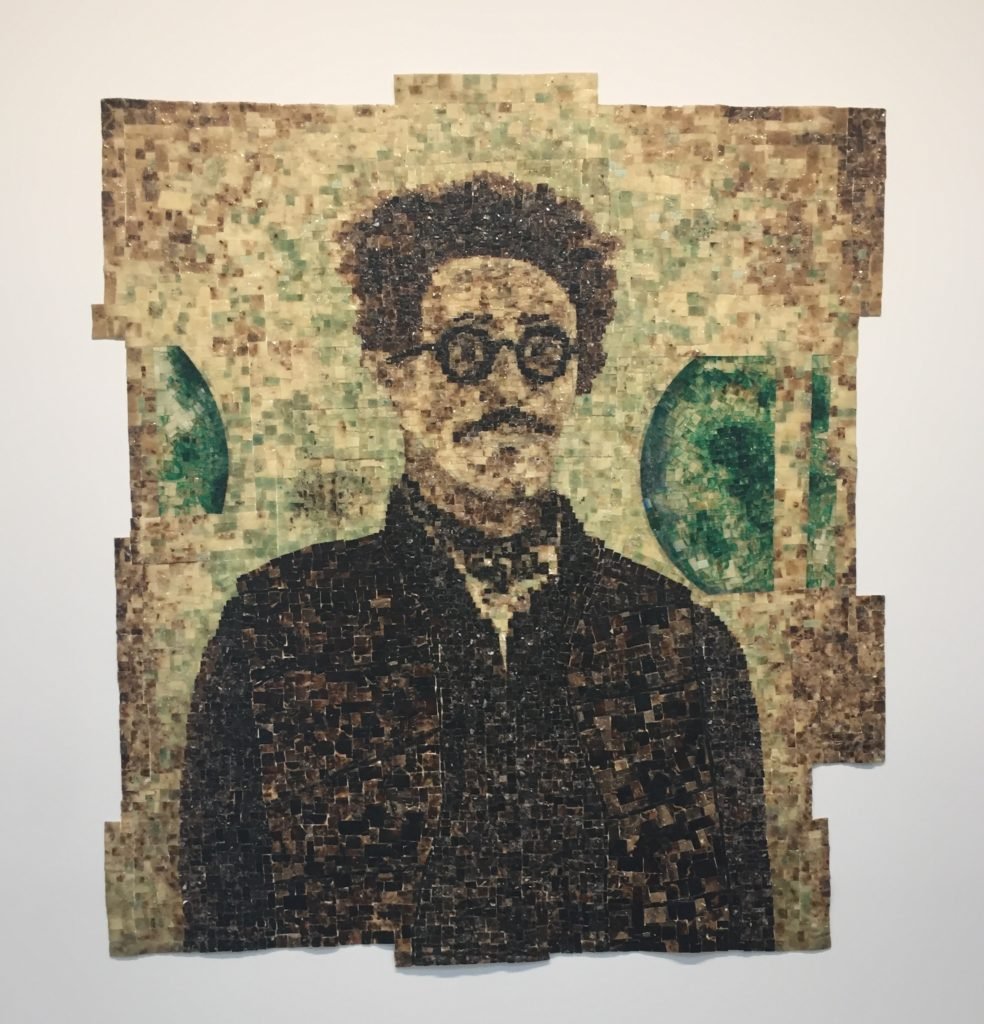Art World
‘I Am Black, Angry, Tired of Teaching, Tired of Being Poor’: Jack Whitten’s Newly Published Journals Reveal a Long, Painful Road to Recognition
A 500-page journal by Jack Whitten is out now from Hauser and Wirth Publishers.

A 500-page journal by Jack Whitten is out now from Hauser and Wirth Publishers.

Colony Little

The first page of Jack Whitten’s book, Notes From the Woodshed, opens with a warning to prying eyes:
“These notes represent my private log. Please do not read—Not meant for publishing.”
Luckily for us, Whitten, who died earlier this year, changed his mind. In 2013, at the age of 73, the highly regarded painter agreed to open his vast archive of journals and studio notes to curator Katy Siegel, who distilled them into a 500-plus-page tome that was recently published by Hauser & Wirth.
The gallery is concurrently running a commemorative survey of Whitten’s abstract work in Los Angeles titled “Self Portraits with Satellites,” while in New York a separate show titled “Odyssey: Jack Whitten Sculpture, 1963–2017” will open at the Met Breuer in September (after appearing at the Baltimore Museum of Art earlier this summer). For those new to Whitten, the book offers instructive and moving insights into his life and the evolution of his process, giving readers a sense of just what makes him so special.

Excerpt from Notes from the Woodshed (2018). Photo: Ed Park, courtesy of Hauser & Wirth Publishers.
Whitten had the methodical mind of a scientist and the laid back, improvisational soul of a musician. He kept an extensive log of his artistic successes and failures, a habit that likely grew out of his days as an Air Force cadet in Tuskegee, Alabama.
The book’s title is a nod to Whitten’s love for jazz, since the woodshed is a private, sacred space for musical experimentation and practice. Notes From the Woodshed is filled with vignettes from the artist’s encounters with musicians, including John Coltrane and Art Blakey, and how their approaches to music informed Whitten’s own artistic practice.
The artist also drew from a deep well of personal experiences over five decades and expressed his curiosity through painting, often posing theoretical questions about art and the materiality of paint. Notes From the Woodshed is arranged chronologically, starting in the 1960s when Whitten reflects on identity as he struggled with global conflict, war, and racial turmoil. At this time, his work directly reflected that pain. He was desperate to redirect that energy.
As he conducted artistic experiments in the years to follow, he came to a creative crossroads in 1972: “I’ve done so much. I’ve tried everything. I’ve tried the saw blade, afro comb… To be as clear as possible without becoming confused. I JUST WANT A SLAB OF PAINT,” he writes.
The elusiveness of paint drove Whitten to create the instrument he called the “developer,” a proprietary floor-based tool he used to quickly spread a layer of acrylic paint onto a canvas in a single gesture. This discovery dramatically altered his studio practice and artistic style, which led to the creation of his signature slab paintings.
With this, he found not just a mode of working, but a philosophy. “I must learn to accept change as being inherent with my type of structure it is not a cookie-cutter-concept. One must allow for change—however rapid: as long as it is within the original boundaries,” he wrote. This realization underscores the importance of change and evolution in the artist’s work.

Jack Whitten, April’s Shark (1974). Photo: Hauser & Wirth, Los Angeles.
Beginning in 1968, the artist started taking regular trips to the Greek island Crete. Finding solace away from the physical and emotional travails of his studio practice, every May he concludes his last journal entry of the month with the words “Gone Fishing!” in all caps. The phrase practically rings off the page like the last school bell of the year.
Untethered from the New York art world, Whitten’s summers in Crete provided him with the creative latitude to explore other media, including assemblage and carved wood sculpture. The work he created on the island became the foundation for the paintings he would later make in his studio in New York. (These works remained in Crete until late 2017 and are now view in “Odyssey.”)
One of the lessons of the book is the importance of this escape from the art world to make his best art possible: When he returned to his studio practice in the fall, he was re-energized and ready to tackle the woodshed.
By the 1980s, however, the physical demands of working with the developer were taking a toll on Whitten’s body, forcing the artist back into the lab for more experimentation with acrylic. As the artist’s process evolved, his paintings and his journal entries demonstrate his desire to discover new materials and processes. Throughout his career, Whitten’s self-portraits became cognitive snapshots of his worldview and his existential grappling with life and work.
In 1984, he created Self-Portrait With Satellites, the work that gives the Hauser and Wirth show its name. It is neither figurative nor abstract. An orbit of rectangles carved into thick brushstrokes of oil and acrylic float on the canvas in a state of conceptual stasis, mirroring Whitten’s thoughts on his practice.
“I don’t know what best describes it,” he writes. “I do know that I am working out of what is generally known as abstraction, but I am heading toward image. When I am carving wood I do direct carving i.e., starting with the raw material without conceptualized intent, the image is arrived at through pure plastic thinking. I want to use this approach in my painting.”
Crippling self-doubt emerges in Whitten’s journal entries during this period, as he struggled through this artistic limbo well into the 1980s. He was forced to balance his financial needs with his desire to push boundaries with his work. His frustrations are laid bare, with candid self-awareness:
“I am back to zero,” he writes. “The only thing I have to salvage from the past fifteen years is the fact of the hard backing; the bringing of the floor up to the wall. This is meaningful. I want to start 1986 with a clean slate. Of course, this destroys any chance of getting a gallery, no one is interested in an artist at the end of a series and beginning a completely unknown beginning. I am black, 46 years old, angry, tired of teaching, tired of being poor. […] What am I to do?”
In the 1990s, Whitten’s paint experiments began to coalesce around the tesserae, the chips of paint the artist formed from cutting slabs of acrylic. His resulting mosaics play with light and center around themes of particle physics, technology, cosmology, code, and bytes of data.
For Whitten, this was another important conceptual shift in his process that bridged the traditional, relational brushwork of impressionist painting with new, contemporary applications of paint. Whitten’s mosaic works were influenced by the light properties found in the individual chips of paint, where the refractions from one piece directed his placement of the next. This became a discovery that buoyed Whitten, giving him the artistic freedom he had been searching for.
This interplay between light and material shines in the paintings at Hauser and Wirth. In E Stamp #1 for Billy, small, iridescent bits of metallic mica shimmer throughout the bright pink and white tesserae tiles. The glimmer gives away the painting’s inspiration: It was a tribute to Whitten’s brother, Bill Whitten—the fashion designer who created Michael Jackson’s white rhinestone glove—who played an important role in his artistic discovery.
According to Notes From the Woodshed, the brothers were on a shopping trip talking about design when the artist asked his brother where he got his clothing ideas from. As Whitten recalls, “he thrust the fabric in my face + rubbed them with his fingers: ‘From the material!’”
This revelation validated the painter’s faith in the process he had been developing. “Now I understand…. All information is carried within the light. If I let go + follow the light… the world is my oyster!”

Jack Whitten, Self Portrait (1996). Photo: Colony Little.
As Whitten documented these epiphanies throughout his journals, the reader can see him methodically shaping the language he used to describe his work. Whitten “made” paintings, he didn’t “paint” paintings, and for the artist, that distinction was an important one. Terms like “slab,” “developer,” and “tesserae” have become common rubrics for curators and writers who study his process.
By 2012, the artist was well into his 70s when he decided that it was time to offer his audience his personal thoughts and theories on art. Perhaps this explains why he finally opened up his archives to Siegel in 2013.
In her editor’s remarks after Whitten’s warning, Siegel observes moments in his writing where his intended audience shifts from private to public, as if he were imagining an audience that would benefit from the lessons he learned in the studio. More importantly, this shift acknowledges Whitten’s confidence to offer up these private thoughts for public consumption. As Siegel reflects on the artist’s change of heart: “the audience he had once imagined now existed and was ready to listen.”

Jack Whitten, E Stamp #1 For Billy (Little Bo Peep) (2007). Courtesy of the estate of Jack Whitten and Hauser & Wirth. Photo: John Berens.
I, for one, am thankful he changed his mind. Without this critical look into Whitten’s private practice we would only have a surface-level understanding of his work. While the artist’s strong command over his own narrative was undoubtedly shaped by documenting his painstaking, methodical process, the real magic of Notes From the Woodshed is found in his personal encounters with others.
We would never know about the important lesson Willem de Kooning taught him about having a role model: “Young painters who are hungry, ambitious, and eager to make a name for themselves need someone to push against,” Whitten writes. “For me it was Bill de Kooning.” Nor would we know about how jazz shaped his theories on art: “Erasing the boundaries between drawing and painting gives me more freedom… Jazz is a philosophy of life, it deals with the expansion of freedom.” And we wouldn’t know about the making of Bright Moments, a work dedicated to jazz musician Rahsaan Roland Kirk, which Whitten considered the one painting that got away.
In Notes From the Woodshed we see how Whitten weaves moments of creative serendipity into his paintings and his worldview, using his writing as a workshop for fine tuning them both. These notes aren’t simply a log of his practice, they reveal the soul imprinted within the work.
Colony Little is the creator of Culture Shock Art.